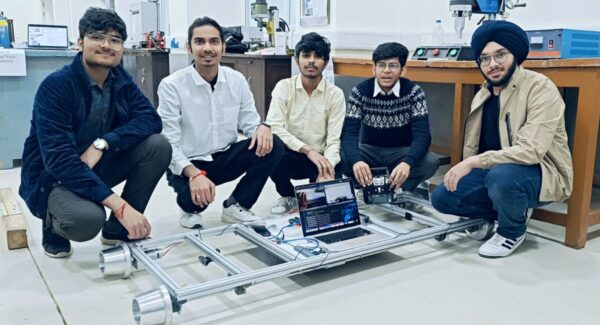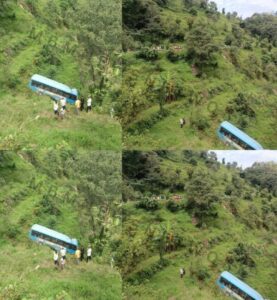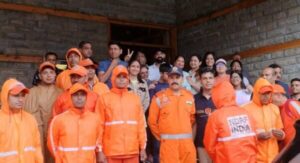IIT Mandi Students Create Revolutionary Automatic Guided Vehicle to Identify Railway Track Defects, Preventing Accidents

IIT Mandi students
Now, an ingenious way to address this problem has been made possible, thanks to one such project by a bunch of students from the Indian Institute of Technology (IIT) at Mandi. One such groundbreaking endeavor, the Automatic Guided Vehicle (AGV) possesses the capability to identify defects in the railway tracks, allowing for a preventative approach to avert any future mishaps.
True Track Inspections – The Issue with Traditional Track Inspections
More than a million passengers travel by train in India every day and with such a large number of people travelling, railway transport has become the lifeblood of the country’s expanding transportation network. Nevertheless, when it comes to the detection of faults in railway tracks, the safety of the railway system has always been a point of concern. The standard technique of track inspection is innate, with inspectors traveling physically down the tracks as the name suggests and taking notice of cracks or faults. It is time-consuming and labor intensive, very prone to oversight, which in turn increases the risk of potentially serious accidents due to undetected defects.
At present, India doesn’t have a specific device of this kind which can effectively trace the cracks and other defects on a railway network. Though the advanced technologies are available worldwide but their usages are minimalistic in INDIA. As a consequence, manual inspections are conducted each year costing millions of rupees, and many of these do not yield complete results.
Innovative Breakthrough from IIT Mandi
To mitigate such problems, a team of six budding and aggressive brainiacs from IIT Mandi under the profitable guidance of Dr. Amit Shukla has developed a wonderful solution; An Automatic Guided Vehicle(AGV) which moves automatically on the pangs of railway to identify hairline cracks and flaws. It has advanced AI cameras and acoustic sensors that help it detect potential cracks, weak spots and structural faults along the tracks.
With a maximum range of 25 km per charge, the AGV is a cost-effective and scalable solution for large areas requiring track inspection. It utilizes AI to analyze the real-time data collected by the camera and acoustic sensors to detect any faults or signs of damage on the track. It then logs the GPS location of all detected anomalies to map the high-hazard locations across the railway network. This is then communicated back to a central control system, where engineers and maintenance teams can view it, letting you know it is time to get repairs scheduled before a minor issue becomes a significant safety risk.
The Vision Behind the AGV
This AGV was developed because, as a lead developer of the project named Parth outlined, “Presently, the washing of railway tracks in India is done manually, which has its drawbacks. Which is time-consuming, and human error can, at times, lead to critical defects evading testing. “With our automatic guided vehicle, we want to leverage contemporary technology to improve the safety and efficiency of railway operations,” add Parth.
He also elaborated on how the AGV offers an alternative to the existing inspection systems. “This is unlike conventional manual techniques that only determine known cracks or defects; our system can determine faults in advance by assessing vibrations and acoustic signals. AI sensors identify micro-cracks which are usually too tiny to be seen by the human eye. Such predictive capability can greatly mitigate the risk of accidents due to failures in the track,” he added.
The Tech That Powers The Innovation: AI Camera And Acoustic Sensors
AGVs rely on a combination of AI-powered cameras and acoustic sensors. AI camera is trained by visibility data of railway track cracks. On the contrary, the acoustic sensor detects vibrations and noises made by the track, allowing it to collect more information about the track condition that may not be visible to the naked eye using traditional inspection methods.
Using the two sensors in conjunction allows the vehicle to gather detailed information about the state of the track. This data is processed in real-time, allowing better detection of flaws that may create problems down the line. This information is then transmitted to a central system that can be accessed and reviewed by engineers and maintenance teams.
Savings for Indian Railways in terms of Cost and Time
This new AGV system is expected to save time and money for Indian Railways. Currently, railway authorities spend a lot of time and money for inspection and repairing, Parth notified. “India spends thousands of crores every year to inspect railway tracks for detection of faults, but a large part of it is spent on manual inspections, which are inefficient and often incomplete,” he added.
Indian Railways will save costs involved in manual labour and the resources spent on conducting frequent inspections by automizing the inspection process using AGV. Additionally, the ability to detect faults before they develop is critical if we are to reduce expensive repairs, loss from accidents, and downtime. It can also help you ensure that repair work gets done in time, preventing long delays due to sudden breakdowns.
Similar Technologies Used Internationally
The AGV, while a revolutionary product for India, is not such a new technology as many developed nations have already relied on it for a long time. In countries such as Japan, Germany and the United States, automated systems and robots are frequently deployed to inspect railroad tracks for defects. These methods have been very effective in detecting issues early and ultimately avoiding accidents, leading to safer operations.
According to Parth, this technology is new to India, but its advantages are infinite. “This technology is already working in foreign countries, and we are trying to see how this can be brought to India as per our needs. We hope to have this technology implemented across the country with the support of Indian Railways and other stakeholders, so that the safety of millions of passengers who depend on the railway network daily is ensured.”
A Move Towards A Safer Future For Indian Railways
Designed by IIT Mandi students, this campus’s Automatic Guided Vehicle is a significant advancement that could greatly enhance the safety and efficiency of the railway system in India. The system is capable of saving lives, cutting costs, and stopping potentially catastrophic accidents by detecting small faults in the tracks early on.
Innovation is key, and technology is a catalyst for solving practical problems, which is what this project demonstrates. As this undertaking progresses, it could revolutionize railway safety not only in India but globally, ultimately leading the way for more intelligent, efficient, and secure transportation networks.
Summary: IIT Mandi students do not only proved have been able to showcase the potential of academic excellence and innovation but also have paved the way for our railway system for a secure future. A mission-critical challenge in need of an innovative solution, they developed an automatic guided vehicle that is timely, cost-effective, and, most important, life-saving.
This initiative would set a strong precedent for any further technological adoptions in India’s infrastructure can be in sectors that directly impact the safety and well-being of the common man. Once tested and implemented, the AGV system will not just be a huge achievement for Indian Railways, but also a global case study for rail networks.

Continuing the achievement of the journey of effectiveness and credibility of more than 10 years in the career of journalism, as a woman journalist, I am Serving as the founder, promoter and editor of DiaryTimes with the trust and support of all. My credible coverage may not have given a big shape to the numbers, but my journey presents articles that make you aware of the exact and meaningful situations of Himachal’s politics, ground issues related to the public, business, tourism and the difficult geographical conditions of the state and financial awareness. DiaryTimes, full of the experience of my precise editorial expertise, is awakening the flame of credible journalism among all of you, so that the eternal flame of meaningful change can be lit in the life of the people of the state and the atrocities being committed against the people can be brought to the fore, I am motivated for that. If even a small change comes with the power of my journalism and the whole world becomes a witness to that issues, then I will consider myself fortunate.








